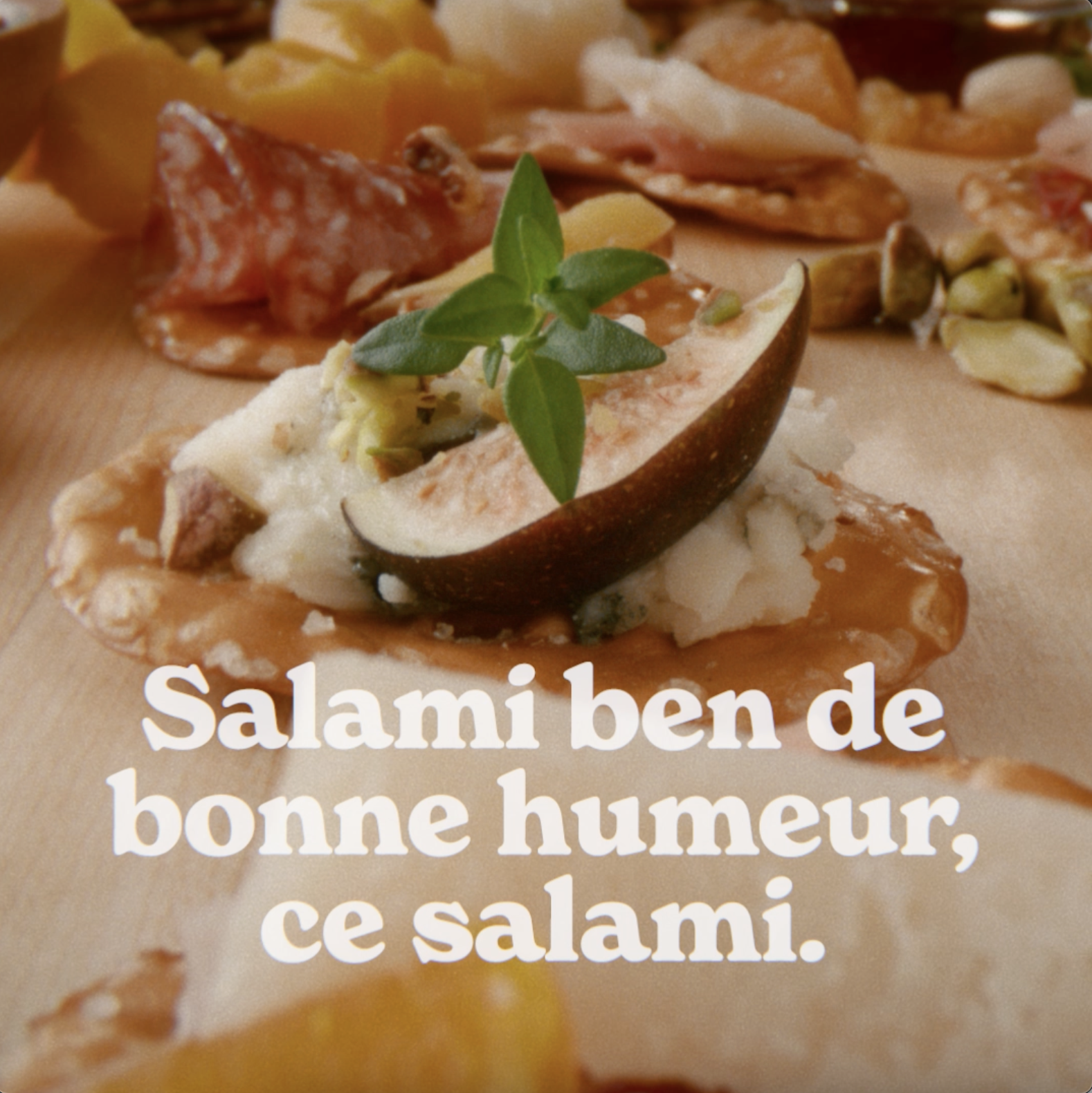on parle

Kindness and Understanding for the Holidays
December 2023
The run-up to a new year is an opportune time to reflect on the one drawing to a close. At the shop, this past year has been filled with rich challenges, fruitful projects and contagious creative energy. Indeed, despite these turbulent climactic and economic times, our artisans were able to muster up the ingenuity and determination to ride the waves. In the spirit of good tidings and cheer, which we wish you and your kin, we invite you to hear from our artisans one last time before the year’s end. So, when it comes to advertising, communications and culture, here’s what’s worth noting (in our humble opinion). Happy holidays!

Does Artificial Intelligence Have a Role in Localization?
As my colleague Audrey explained in her article on ChatGPT, artificial intelligence is increasingly used in advertising and written content creation. Although it can accelerate the process of translation by automating and facilitating some functions, its integration raises concerns about its capacity to replace some of the tasks that are traditionally done by agency copywriters. Not asking ourselves the question would be burying our heads in the sand: should we worry about the meteoric rise of artificial intelligence in advertising and, more specifically, in localization?
To create a memorable message, our work requires a specific sensitivity to the nuances of language and culture. It is this kind of detail that differentiates a powerful campaign from a generic one.
For AI to truly excel in advertising, it has to overcome a number of challenges, especially in regions where language and culture are central. Québec is a very good example of that, because of the distinctive linguistic features of its French and its rich and unique culture. So, to be efficient, AI has to master those specific features of Québec French and show an in-depth understanding of local cultural references. Even though AI is impressive at what it does, it has yet to reach this level of understanding within a specific cultural context to truly succeed in producing ads, especially in a market as unique as Québec.
I played around with ChatGPT and asked it to come up with a 30-second ad for a coffee company, feeding it with as many cultural codes and expressions as possible. After a few attempts, the AI was unable to go much further than “open on a festive melody resembling Québec folklore music, with lively images of the snow-covered streets of Québec”.
Sure, integrating AI has its benefits, but it cannot replace humans. Cultural awareness and creativity are areas in which copywriters thrive and where they would be hard to replace, especially in nuanced linguistic and cultural contexts like Québec. We are keeping an eye on AI in advertising, but for now, there is nothing to worry about when it comes to localization. After all, we are the Québec experts!
Jessica Dubois Lefort, Account Supervisor

Does the Younger Generation Really Speak Poorly?
The short answer is: not at all.
Before working in advertising, I studied linguistics. For a long time. In 2020, I completed a doctorate on the linguistic characteristics of spoken French in Québec and taught the linguistics of Québécois French at the university level for several years. The main takeaway from my academic tenure was that, in Québec, our national pastime isn’t actually hockey—it’s worrying about the French language. Everyone has an opinion, whether in the National Assembly, in the media, in the streets, or around the table.
For one, we get fired up over less-than-desirable French proficiency levels. We also find ourselves up in arms over the extent to which the language of Shakespeare, newcomers, bilingualism and federal institutions threaten the vitality of French in Québec, the "precious jewel" imported from the old continent that sets us apart in North America. But the worst threat of all? The youth! They stand accused of massacring the language and jeopardizing its future. Such accusations are not new: A young Molière and a young Michel Trembley were once charged with the same crime.
The thing is…language is, first and foremost, a tool we use to relate to others. As a result, it can only be useful to speakers if it adapts to their needs! The best way to make a language disappear is to render it useless by not allowing it to transform and meet changing communication needs. To perpetuate a language, you have to encourage it to evolve.
We celebrate technological advancements (where would we be without the internet, airplanes or electricity?), so why should we glorify a fossilized version of the French language over the linguistic innovations of the younger generation as they attempt to master a tool that belongs to them, too.
Scientific studies show that, regardless of the standards set by schools, young people do what they want with the language they speak, from adding different verb endings to borrowing from English and other languages (Haitian, Creole, Arabic, etc.) and using abbreviations and acronyms.
Advertisements that reflect local culture and use relevant language create stronger links with consumers. So, we shouldn’t hesitate to speak to young people differently from how we speak to their parents. They are, after all, the adults of tomorrow. That means using "tu" on Snapchat and "vous" on Facebook, for example. Speaking your audience’s language is the winning formula for effective advertising localization!
Further reading and listening:
“La parlure des ados,” L’actualité
Ainsi soit-chill podcast by Jérôme 50, available on the OhDio platform
Dr. Béatrice Rea, Copywriter

Advertising That Works for Everyone
I'm epicene, gender-neutral or non-binary. I often have median points or parentheses, and sometimes I use "le doublet complet" or abbreviations. I'm taking up more and more space in the media as a topic, a norm, and a writing practice. What am I? Inclusive writing.
Inclusive writing is indeed infiltrating the media space, which is why, as an integral part of this space, it’s important for us to address it, understand what it entails, and know how to use it.
For those unfamiliar with inclusive writing in French, here’s a short definition: inclusive writing is a form of expression that recognizes and includes all genders in words used to describe a person. With inclusive writing, the masculine form of the word is no longer used as the default stand-in for male and female. There are many ways to incorporate gender-inclusive language depending on the context, the message, the space, etc., but regardless of the approach, the goal is for each person to feel that he/she/they is included in the conversation.
In advertising, inclusive writing engages a larger part of the population, simply because it no longer exclusively targets one gender. It also demonstrates that a company is not only responsive to social issues, but also recognizes the different identities of its audience members and is committed to forming a closer connection with them. Finally, the message itself helps to create a more inclusive and respectful media space.
It’s also important to consider that inclusive writing is a contentious topic for certain audiences. Some people find it unnecessary, complex, politicized or intrusive. But no one better understands the impact that linguistic choices can have on consumer behaviours than you (and us). So, when deciding to use inclusive language to advertise a product, it's important to not only choose the language that best suits your target audience, but also to ensure that the reception of the message is not compromised.
Several language authorities have developed writing guides to help unpack the complexities and techniques involved in inclusive writing, many of which are available online. These are excellent tools to understand the issues at hand and explore what inclusive language can achieve on a larger scale.
Once demystified, inclusive writing is a practice that advertisers must consider with care, as it comes with a fair amount of political baggage.
Camille Roy-Tremblay, Translator and Editor

Quebec’s Gastronomy: Uniqueness, Served.
Laurent Dagenaux, Cassandra Loignon, Trois fois par jour, Amine Laabi, Folks & Forks. Do these names ring a bell? Probably, since they are a part of the vibrant patchwork that is Québec’s contemporary culinary landscape. However, if we go back a few decades, the classic steak-corn-potato (expression referring to Québec’s Shepard’s pie) was the staple for most Québécois families. Fine cuisine existed, sure, but to a much lesser extent, as it was less popular and less affordable. Culinary TV shows and social media have greatly contributed to giving Québec’s gastronomy its cool-kid status and its new modern look.
All of this explains why we are seeing more and more food content creators succeed both within and outside of the province. These foodies shine a light not only on the industry, but also on Québécois culture. If Quebec is well known for its legendary joie de vivre, it’s mostly due to its boundless love of food. It’s no secret—food makes us happy (at least local food does!) So, even if our revenue is under the Canadian average, food is not something we compromise on, as we spend just as much as other provinces on food, whether at home or in restaurants. For the Québécois, eating is more about enjoyment than sustenance.
It’s a cuisine that most would characterize as hearty, festive, and far from pretentious, but mostly, it’s a cuisine that puts local products in the spotlight. These same traits are often used to describe the Québécois, so it’s safe to say they are an undeniable part of our identity. On another note, contrary to most restaurants across the globe that are financed through private investments, the majority of Québec’s restaurants (57%) see the light of day because the owner has poured their every penny and ounce of passion into them. This means that ROC advertising agencies who wish to work with food influencers from Québec have to understand the uniqueness of our gastronomy in order to create relevant and engaging content. When they grasp the character and the value of Québec’s cuisine, it’s clear that they have understood who we are at the core.
Moreover, gastronomy plays a critical and strategic role in Quebec’s tourism industry, as well as in its development and the revitalization of its remote regions. A recent report showed that, after the shake-up caused by the COVID pandemic, women, marginalized communities, and youth are revolutionizing the industry. It bodes well for the future, and it makes us want to support our local restaurants, which are internationally renowned for a reason. Are you hungry yet?
Sabrina Desjardins, Account Supervisor

Snack Factory Adds the Seasoning to Holiday Advertising
It’s a well-known fact that, in the world of marketing, Christmas means… Christmas ads. It's a particularly auspicious period for brands in the food industry as they each vie for a place on holiday tables across the country. But it's not enough to simply whip up a campaign showcasing Québec’s traditional dishes (ragoût, turkey and tourtière). Brands have to reinvent themselves and take different approaches to stand out from the crowd.
With this in mind, Snack Factory commissioned our partner agency to create a zippy holiday campaign for its Pretzel Chips. The campaign consists of 15- and 6-second spots, which combine appetizing visuals with playful taglines that infuse wordplay with cultural insights to highlight the crackers’ distinctive qualities.
From a localization perspective, it's always a challenge to adapt idioms, cultural references or figures of speech. More specifically, our aim is to honour the creative produced by our English colleagues and respect the intent of the original message, while making the campaign not only digestible for a French-speaking audience, but also culturally grounded and linguistically sound. In other words, we don’t just translate words: we translate the essence of the message. At The French Shop, mandates like these aren’t just part of the job—they’re what get us up in the morning and drive us to excel each day.
Getting back to the crackers, our challenge was to convey the playfulness of lines like, "It can introduce your sister to a great gruyère/who’s not into crypto," which features a pun (guy/gruyère) and a cultural reference to crypto bros. In French, gruyère is swapped for "beau grand Suisse," and cryptocurrency is out, as the crypto bros phenomenon is not as widespread in Québec. The full line reads: "Il peut présenter votre sœur à un beau grand Suisse/qu'y chante pas la tyrolienne." With this adaptation, we still play the dating game, but we replace the Anglo socio-cultural archetype with one from the French-speaking world. The aim is to create a strong image in the audience’s mind and, of course, to make them smile.
And what better way to position the campaign in Québec than with a well-known local voice? We enlisted Denis Bernard, Québec theatre and soap opera veteran, to lend his voice to our messages. With his deep, comforting timbre, he really puts us in a holiday mood, adding just the right amount of sugar and spice to convey the underlying tongue-in-cheek humour of the campaign.
Put all these ingredients together and you've got a festive and scrumptious campaign that’s a refreshing change from the usual advertising landscape—one that'll make you want to give pretzel crackers a special place among your appetizers this year.
Catherine Renaud, Copywriter
